"He is afraid. He is alone. He is three million light years from home." The Christ figure in this Steven Spielberg film is none other than the title character, E.T. – a squat, wrinkled alien no more than three feet tall. [Instructor Comment: So, not ontologically human.] It is clear that he would never pass for human. Suggested likenesses offered in the film range from coyote to iguana, leprechaun to goblin. His chest cavity is transparent, revealing a "heart light" that shines when he is in communication with his mother ship. Finally, when using his special ability to cure sickness and restore life, E.T. touches his subject with an index finger that glows brightly.[1] Yet even in his difference, there is enough of what makes us human found within this alien frame to make us feel secure and at home in his presence. Though the physical strangeness of this character could be off-putting, Spielberg went to great lengths to ensure that E.T. would have many human expressions and gestures. [Instructor Comment: Psychologically human-like?]
 E.T.’s eyes were based on photographs of Albert Einstein, Ernest Hemmingway and Carl Sandburg in an attempt to give him a wizened look that conveys gentleness and wisdom. As a result, children the world round immediately identified with the little lost alien. I was no different when I first saw E.T. at the age of twelve and to this day I am still deeply stirred by several scenes in the film. Several points still move me to tears, ranging from E.T.’s wide-eyed fascination with the towering trees of a California forest that have grown from saplings like the ones he has landed to collect to the kindness and sensitivity he displays in his interactions with Elliott. I admire E.T. for his adventuresome spirit and ingenuity, as well as the other-worldly calm he exudes through much of the film. [Instructor Comment: Would that suggest Alexandrianism with a psychological model of incarnation?] And I am deeply moved by the scenes of dying, death, resurrection and final departure. I am heartened by the thought of a God who populates the universe with such noble and inspiring creatures.
E.T.’s eyes were based on photographs of Albert Einstein, Ernest Hemmingway and Carl Sandburg in an attempt to give him a wizened look that conveys gentleness and wisdom. As a result, children the world round immediately identified with the little lost alien. I was no different when I first saw E.T. at the age of twelve and to this day I am still deeply stirred by several scenes in the film. Several points still move me to tears, ranging from E.T.’s wide-eyed fascination with the towering trees of a California forest that have grown from saplings like the ones he has landed to collect to the kindness and sensitivity he displays in his interactions with Elliott. I admire E.T. for his adventuresome spirit and ingenuity, as well as the other-worldly calm he exudes through much of the film. [Instructor Comment: Would that suggest Alexandrianism with a psychological model of incarnation?] And I am deeply moved by the scenes of dying, death, resurrection and final departure. I am heartened by the thought of a God who populates the universe with such noble and inspiring creatures.
Several plot elements of the film are similar to portrayals of Jesus in the gospels. Like the baby Jesus of the Matthew and Luke narratives, E.T. comes into a world of darkness, symbolized by night. [Instructor Comment: Nice parallel. Also, as in John, he pre-exists his entry into this world.] He is immediately sought out in the darkness by men who appear to function as a polyvalent symbol:
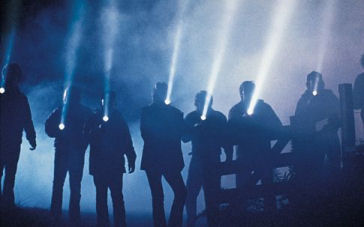
Are these scientists and military men the Magi of the modern age or are they the religious authorities and rulers of this world who seek to destroy the visitor from the heavens? It is no longer clear. In our own time these two groups have merged into one as science and engineering have been co-opted by the military industrial complex.
| Matthew’s gospel reports Jesus to have said, "Truly I tell you, unless you become like children you will never enter the kingdom of heaven" (18:13). In this vein it is to a young boy that the alien reveals himself. [Instructor Comment: Are children, then, a symbol of innocence, or primordial wisdom, or healthy priorities and instincts?] | 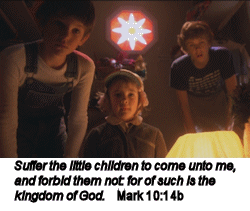 |
 |
And Elliott, in turn, tells his sister, Gertie, "Grown-ups can’t see him, only little kids can see him." This truth is evidenced later in the film when Gertie and her mother share the living room and kitchen with E.T. Though Gertie talks incessantly about her new friend and tries to introduce him, her mother is distracted with the "grown-up" concerns of the cost of groceries and a Ragu stain that didn’t come out of her dry cleaning. With her focus totally consumed by the cares of this world, Mary totally misses out on the presence that has come among them. |
| With no place to call his own, E.T. finds a home among the stuffed animals in a closet between the children’s bedrooms, invoking the memory of a child born in a stable and placed in a feeding trough because there was no room for him in the inn. [Instructor Comment: Yes. Good point.] | 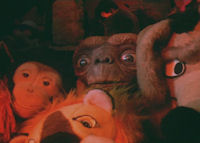 |
E.T. is also similar to all four gospel accounts of the life of Jesus in that he dies and experiences resurrection. Finally he ascends into the heavens in a way that might be seen as parallel to the portrayals given in Mark and Luke/Acts. [Instructor Comment: Exactly]
The image of E.T. differs from Jesus in several significant ways as well. While the early church had disputes over the incarnational reality of Jesus, all four gospels report a man who at least walked the earth in human form. However, E.T. is clearly not of this world and there is no chance that he could be taken physically for a human being. [Instructor Comment: Ontologically at least, this would point to Docetism.] In addition, the little alien is rather quiet outside of his quest to return home. [Instructor Comment: That part is quite Gnostic.] There are no parables or prayers or sermons. [Instructor Comment: Right. And no overt, intentional creation of an alternative society.] However, he does manage to sum up much of Jesus’ teaching in the first English phrase that he ever utters as he learns to speak watching Sesame Street: "Be good."
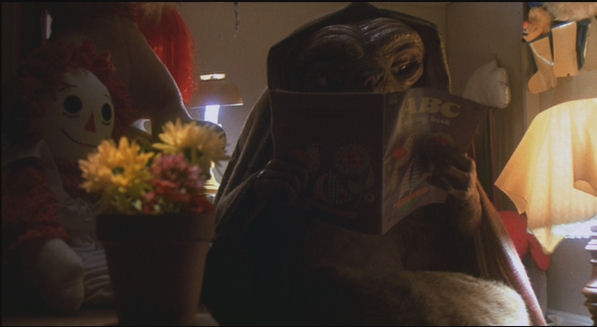
Though it may perhaps go without saying, the initial Christological image conveyed by our hero is Jesus as the Strange Presence of God. [Instructor Comment: Yes, he is associated with transcendence.] However, as the film unfolds, we will also find several other Jesus motifs as well: Life-giver, Liberator, Sacrifice, and Victor.
As Life-giver we find a being that restores wilted and dead flowers to a state of vibrant beauty. [Instructor Comment: Exactly. This fits with Jesus the miracle-worker.] This symbol indicates the death of E.T. and his subsequent resurrection in the film. But the more obvious instance is an allusion to the image portrayed in Michelangelo’s Creation of Adam, in which the divine spark of life passes from E.T.’s finger to Elliott’s, instantly healing a cut that he had just received. With his touch, E.T. is able to set right the ills of this world.
 |
 |
As Liberator we see E.T.’s compassion for frogs that are about to be dissected alive as a part of Elliott’s biology class. Through his symbiotic link with Elliott, he urges the boy to release first his own frog and then all of the others in the lab. Before long the other students also revolt against the teacher and the questionable practices of animal cruelty promulgated in his classroom. [Instructor Comment: Here, there is a hint of systemic critque and reform.]
The image of Jesus as Sacrifice is also present in the film, though at first its presence may be somewhat obscured. In the scene where E.T. heals the cut on Elliott’s finger, a parallel story is being acted out and overheard from the next room as Mary reads excerpts of to Gertie as a bedtime story. In the book, Tinkerbelle recognizes that Peter’s medicine has been poisoned by Captain Hook and rather than allowing him to ingest it, she quickly grabs it away and drinks the poison herself. It is at this point in Mary’s narrative that E.T. touches Elliott’s finger, presumably taking the wound into himself. In the bedtime story Tinkerbelle is dying, but Peter urges all children who believe in fairies to clap their hands. Their applause (or perhaps more accurately, their belief) brings Tinkerbelle back to life again. A similar expression of belief later precedes E.T.’s return from death. [Instructor Comment: Excellent point. Interestingly, this sacrifice is not for the purpose of atoning for sin, but rather to restore life. It is rather like The Green Mile.]
As the arc of the film continues, both Elliott and E.T., who are empathically bound to one another, become sick. There are two possible explanations. It is possible that E.T. is susceptible to some microbe or other environmental agent on the earth that is wearing him down. However, the more likely scenario appears to be that E.T. is continuing to take on the hurts of the world around him and, more specifically, Elliott’s own sickness. Later, the bond between E.T. and Elliott dissolves, allowing Elliott to return to normal physical health as E.T. breathes his last breath and dies. [Instructor Comment: Which fits in with the "life-giver" motif.]
But death cannot keep its prey. E.T. soon returns to life, completely healed and displaying greater telekinetic power than he has previously evinced. Before he had managed to lift himself and Elliott into the air, but the risen extraterrestrial is now able to raise not only himself and Elliott, but also four other boys as they overcome the powers (represented by special agents and police) that are attempting to hold them down. Following one of the models of the Cappadocians, this Jesus-figure simply comes into direct conflict with the rulers of this present world and overpowers them. Here he embodies the Christological image of Jesus as Victor. [Instructor Comment: Yes. In a very overt and major way.]
Within the film we also find an atonement doctrine. When Elliott first begins to tell E.T. about the world as he understands it, we are provided with some interesting insights into the human condition. Elliott shows off an impressive collection of Star Wars action figures: Greedo, Hammer Head, Walrus Man, Snaggletooth, Lando Calrissian and Boba Fett. After introducing the cast of characters he announces, "Look, they can even have wars," and simulates the sounds of blasters firing and the death of a gasping Greedo.
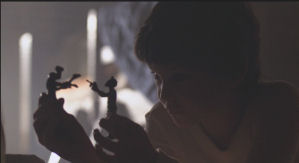
E.T. appears somewhat alarmed at the play violence.
Elliott’s attention turns to the fishbowl: "And look, fish. The fish eat the fish food, and the shark eats the fish. But nobody eats the shark."
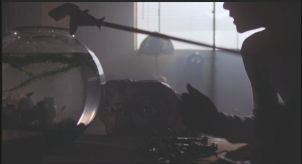
In this brief explanation of child’s play, Elliott has succinctly outlined the rules of the might-makes-right world in which he lives. There seems little hope for either children or stumpy aliens who find themselves stranded among these savage people. [Instructor Comment: Do you think the implication is that contemporary culture is a bit twisted, or that human nature is fallen?]
| The effects of the human condition are clearly seen in the observance of the Halloween "celebration" that takes place after sunset. Michael dresses up as a maimed character with a knife through his skull while Elliott becomes a hunchback. On the street, people walk about in grotesque costumes, dressed as mutilated victims and the walking dead. E.T., not understanding the ritual aspects of Halloween, sees these people and wants to heal them. What to most of us is merely a yearly dress-up party is for the newcomer an outward manifestation of the internal problems of people’s lives. [Instructor Comment: It is a suggestion of sadism, at the least.] Mary has stipulated that the children are to be home by one hour after sunset, knowing what lies ahead as the night’s festivities turn to carousing. But when the children do not come home, her maternal instincts compel her to go out into the streets looking for them. |  |
What she finds is a world turned upside down, where order has been completely usurped. Adolescents run through the neighborhood, throwing rotten eggs at her car.
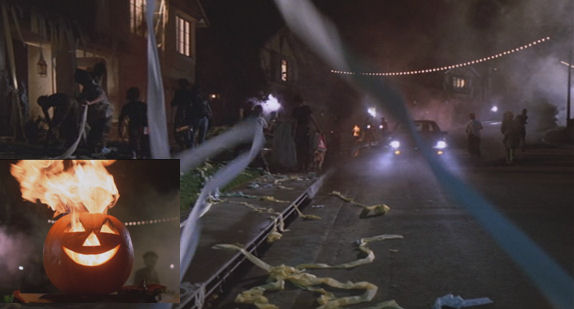
She must look out for flaming trashcans that roll through streets as screaming figures run amok. This is the hell in which human beings live. [Instructor Comment: A clear image of a fallen world.]
Within the family there are problems as well. Elliott’s parents have recently separated; his father has gone off to Mexico with his new girlfriend. Those who are left behind are not coping well, and Elliott feels abandoned. When he tries to tell of his initial encounter with whatever was in the garage, he is met with derision and disbelief. [Instructor Comment: Interpersonal alienation.] He knows his father would believe him if he were around, but he is not. Though perhaps physically surrounded by other people, Elliott is alone. The same can be said for Mary, who is left to raise three children, maintain the house and work outside of the home. Mary’s own grief fills the house, creating a space where her oldest son, Michael, tries valiantly to act as though nothing is wrong and to protect his mother from any mention of what he knows his father to be doing in his new relationship. Gertie is perhaps too young to fully understand what is going on between her parents, but she too suffers from her own sense of loneliness and isolation without friends her own age to play with. From the beginning of the film the overwhelming problem of humanity appears to be estrangement from God, consequent loneliness and a loss of the cosmic order. The original Shalom has been disrupted.
The solution to the family’s problems is found in reconnecting them in a loving, supportive community. E.T. does this in two ways. With Elliott he forms a deep, empathic bond through which he is able to share in all of the young boy’s burdens. As previously noted, there are some suggestions in the film that perhaps E.T. even takes on Elliott’s physical maladies as a part of the healing process. Through their symbiotic bond, E.T. and Elliott are melded into one, sharing the same feelings. [Instructor Comment: Is E.T. slowly taking on human nature? Is this a gradual incarnation (via progressive identification with Elliot, whose name begins and ends wtih "E-T")?]
In fact, when Mary tries to separate the two, it is the dying E.T. who cries out, "Mama!" in his distress.
 |
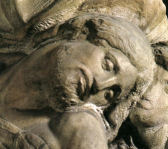 |
It is in this empathic sharing that Elliott finds his own reconciliation and is able then to draw others into his plan to help E.T. return home. Second, through their attempts to help E.T. the mother and her children find a common goal around which they are able to rally. After helping their alien friend to reconnect with his mother ship they find themselves strengthened as a family. [Instructor Comment: This sounds Abelardian. The display of empathic love awakens love.]
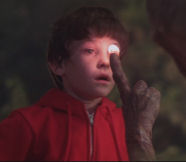 The film’s image of atonement is compatible with the idea of an empathic subjective mechanism. [Instructor Comment: Yes.] E.T. proves to be loving and kind, bringing healing and new life into every life that he touches. In turn those around him find themselves responding in positive ways. We are not quite sure what happens after the movie ends; however, the family has come together as one in an emotional farewell. Michael has given up his antagonism with Elliott and appears to have grown from the experience. Gertie displays kindness and generosity as she presents the botanist from space with potted flowers to take back to his onboard greenhouse. Elliott appears somehow older and wiser, no longer the scared child he had been at the beginning of the film. E.T. has touched his finger to Elliott’s forehead and announced, "I’ll be right here." [Instructor Comment: Promise of the Holy Spirit?] Though they will be physically separated, the boy and the Life-giver will still be connected in thought and feeling. (It is interesting to note that Elliott and E.T. share the same first and last initials. It is as though Elliott has been brought into E.T.’s reality: E.lliotT.) [Instructor Comment: Right. E.T., in a way, is incarnated in Elliott.]
The film’s image of atonement is compatible with the idea of an empathic subjective mechanism. [Instructor Comment: Yes.] E.T. proves to be loving and kind, bringing healing and new life into every life that he touches. In turn those around him find themselves responding in positive ways. We are not quite sure what happens after the movie ends; however, the family has come together as one in an emotional farewell. Michael has given up his antagonism with Elliott and appears to have grown from the experience. Gertie displays kindness and generosity as she presents the botanist from space with potted flowers to take back to his onboard greenhouse. Elliott appears somehow older and wiser, no longer the scared child he had been at the beginning of the film. E.T. has touched his finger to Elliott’s forehead and announced, "I’ll be right here." [Instructor Comment: Promise of the Holy Spirit?] Though they will be physically separated, the boy and the Life-giver will still be connected in thought and feeling. (It is interesting to note that Elliott and E.T. share the same first and last initials. It is as though Elliott has been brought into E.T.’s reality: E.lliotT.) [Instructor Comment: Right. E.T., in a way, is incarnated in Elliott.]
As the film ends, the alien spacecraft streaks across the sky, leaving behind a rainbow as a sign of the promise that E.T. has made to Elliott.

In the gospel narratives we are told that anyone who believes in Jesus will receive new life. So it is with E.T. When the scientists and military personnel had quarantined the family and hooked Elliott and E.T. up to various monitoring devices, Elliott had protested, claiming that E.T. had come to him and asserting some kind of proprietary relationship. But Keys responds that this event is bigger than the boy has imagined. "Elliott, he came to me too. I’ve been wishing for this since I was 10 years old… His being here is a miracle… It’s a miracle, and you did the best anyone could do. I’m glad he met you first." Through witnessing the sacrifices that E.T. and Elliott have made, the grown Keys is changed: his imagination is renewed and his faith in something bigger than himself is restored.
Because it is clear from the beginning that E.T. is a creature from another planet, the Ebionitic and Antiochene doctrines of the incarnation are immediately ruled out. [Instructor Comment: Yes.] This Jesus-figure is neither all-human nor is he a human who comes into a revelation of his divine nature. A Docetic view is entirely possible, as a case can be made that even E.T.’s most human gestures are merely affectations picked up from interactions with Elliott and the others. However, I am more inclined to an Alexandrian understanding. [Instructor Comment: I agree. At least he psychologically begins to participate in the human nature. This is interesting, because in the psychological model, the focus is usually on a human identifying spiritually with God. Here, however, it is the other way around. God identifies with a human.] Like the human scientists who study him, E.T. has DNA, though it is not arranged in quite the same way. This creature comes down from the heavens, but he also embraces the experiences provided through the humans around him in a process of discovery that seems to be a reverse of the Antiochene doctrine. E.T. is totally Other when he first appears, but as he observes and participates in the world around him he begins to display the nobler aspects of what it means to be human. He is able to love and to share in the concerns and hurts of others.
E.T.’s other-worldly origin leads to an ontological model of the incarnation: at the most fundamental level of existence, the creature is different from the humans among whom he has come to live. However, there are elements presented in the film that can be interpreted to fit other incarnational models as well.
For example, at the beginning of the film, when E.T. is in communication with the mother ship, his heart light shines brightly. However, when he is left behind, the heart light’s glow fades away. It does not reappear again until the resurrection scene when E.T. has received some sort of communication indicating the imminent return of the mother ship. The heart light then glows with great intensity throughout the rest of the film, indicating communion between the alien and the Source (in this case, the mother ship).
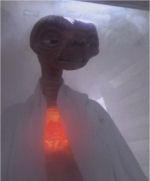 |
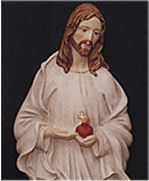 |
As if to drive the point home, Spielberg equips the mother ship with a radial aperture which dilates and constricts to form a door. As E.T. prepares for his final ascension at the end of the film, the shrinking door brings the viewer’s focus to the heart light as the final glimpse of the alien envoy.
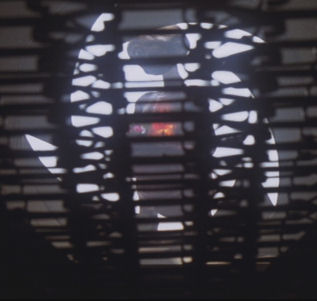
As long as contact is maintained between the inner consciousness of the creature and the Source, the heart light glows and E.T. brims to the full with life and vitality. Through his uninterrupted contact with the Source-consciousness E.T. becomes a manifestation of the Source. This is a clear example of a psychological model of the incarnation. [Instructor Comment: Exactly. Even the "phone home" mantra points to the centrality of communication in the film. E.T. is who he is by virtue of who he is communicating with.]
Finally, an argument can also be made for a revelatory model of incarnation. E.T. is naturally curious and adventuresome. He shows great empathy for the wounded and dying and a keen desire to bring new life and energy to everything that he encounters. He eschews violence and exudes an other-worldly calm and peace. In all of his interactions E.T. reveals the nature of a benevolent and loving Other. [Instructor Comment: Right.] Through this particular Jesus-figure we are given glimpses into the nature and being of God. This is the essence of a revelatory model of the incarnation.
Thus, in the images found in E.T. the Extra-Terrestrial, we are able to find many echoes of the gospel narratives and the images that have been associated with Jesus over the past two thousand years. We find a world in which the problems of suffering and alienation are ubiquitous. We find an other-worldly presence who empathically suffers with humanity and through his identification, takes on and sanctifies that suffering. But additionally, through his nonviolent and loving nature, E.T. is able to inspire humanity and bring about a transformation in the hearts of those with whom he comes into contact.
[1] E.T. only has four fingers, so schisms over the orthodox positioning of his fingers to represent the two natures of Christ and the Holy Trinity can be avoided altogether. [Instructor Comment: Good point.]
Instructor Evaluation
Excellent work! Exceedingly thoughful and insightful. You do a wonderful job of identifying NT parallels and divergences. Loved reading it.
You drop big hints that not only is this Abelardian (triump of empathic, transforming love), but it also has strong Christus Victor nuances, with life triumphing over death.
I think you are quite right that ontologically this is close to Docetic, but psychologically it is Alexandrian.
Also
Jesus was …cut off…or "forsaken" in death, separated from the living God.
ET was also seperated from …his source, until resurrection, just like Jesus.
Great essay!
The movie missed one important thing: After the ascension of ET, some Adventists could have realized ET was the "second coming" of Jesus that even they, the Adventist believers, did not recognize or understand. He went back "home", misunderstood by Earthlings.
I think about the Apostles’ Creed. Descended to earth. Heal by touch. Dies. Comes back to life. Ascends back where he came from. Elliott’s mother was named Mary.